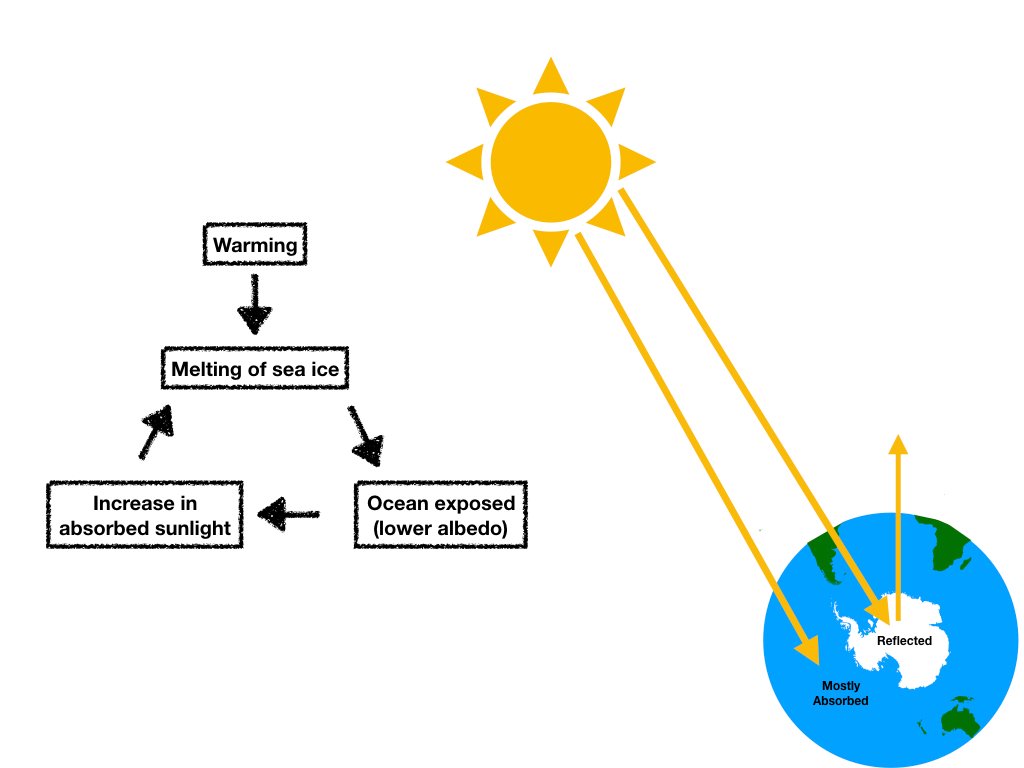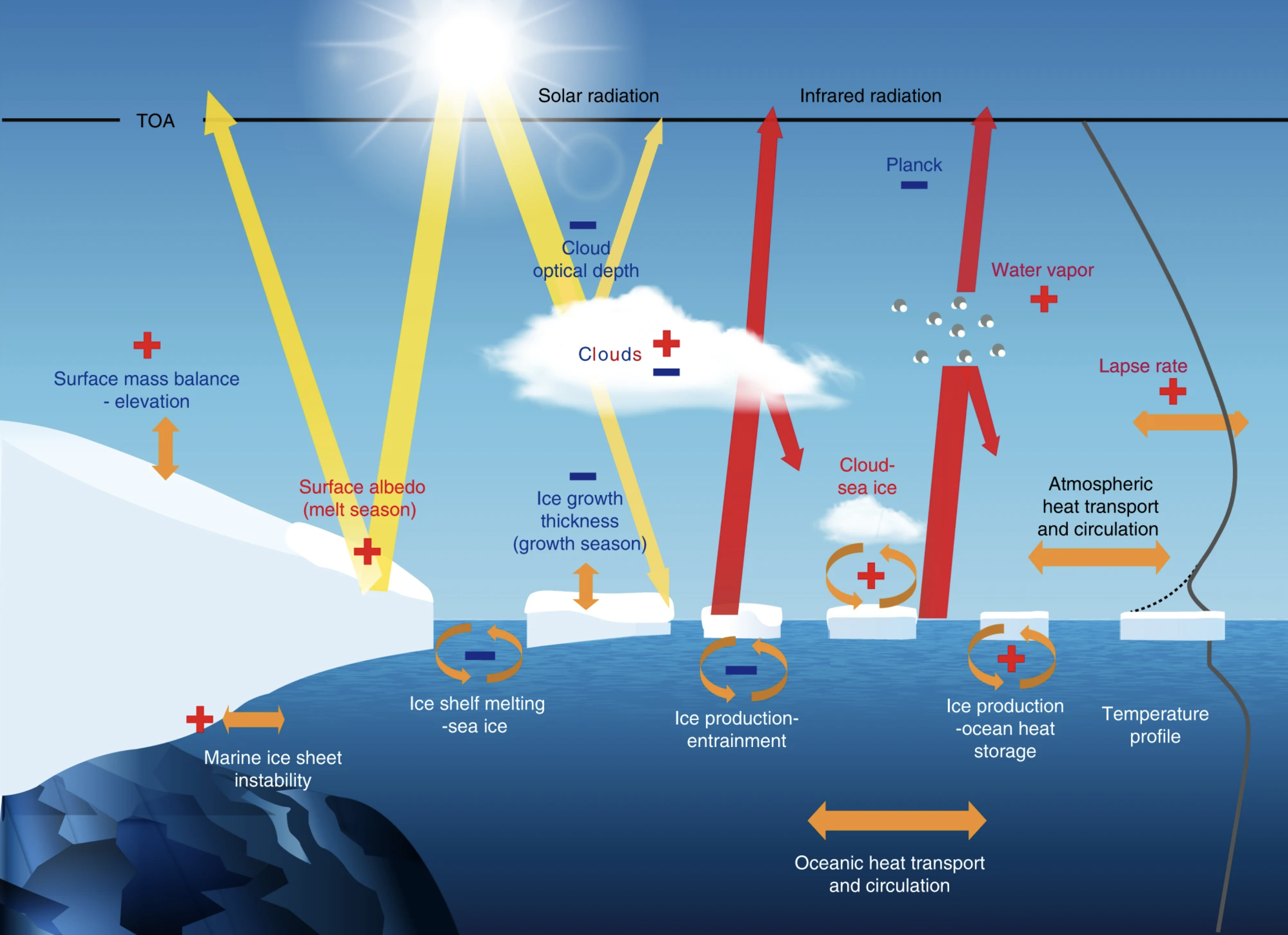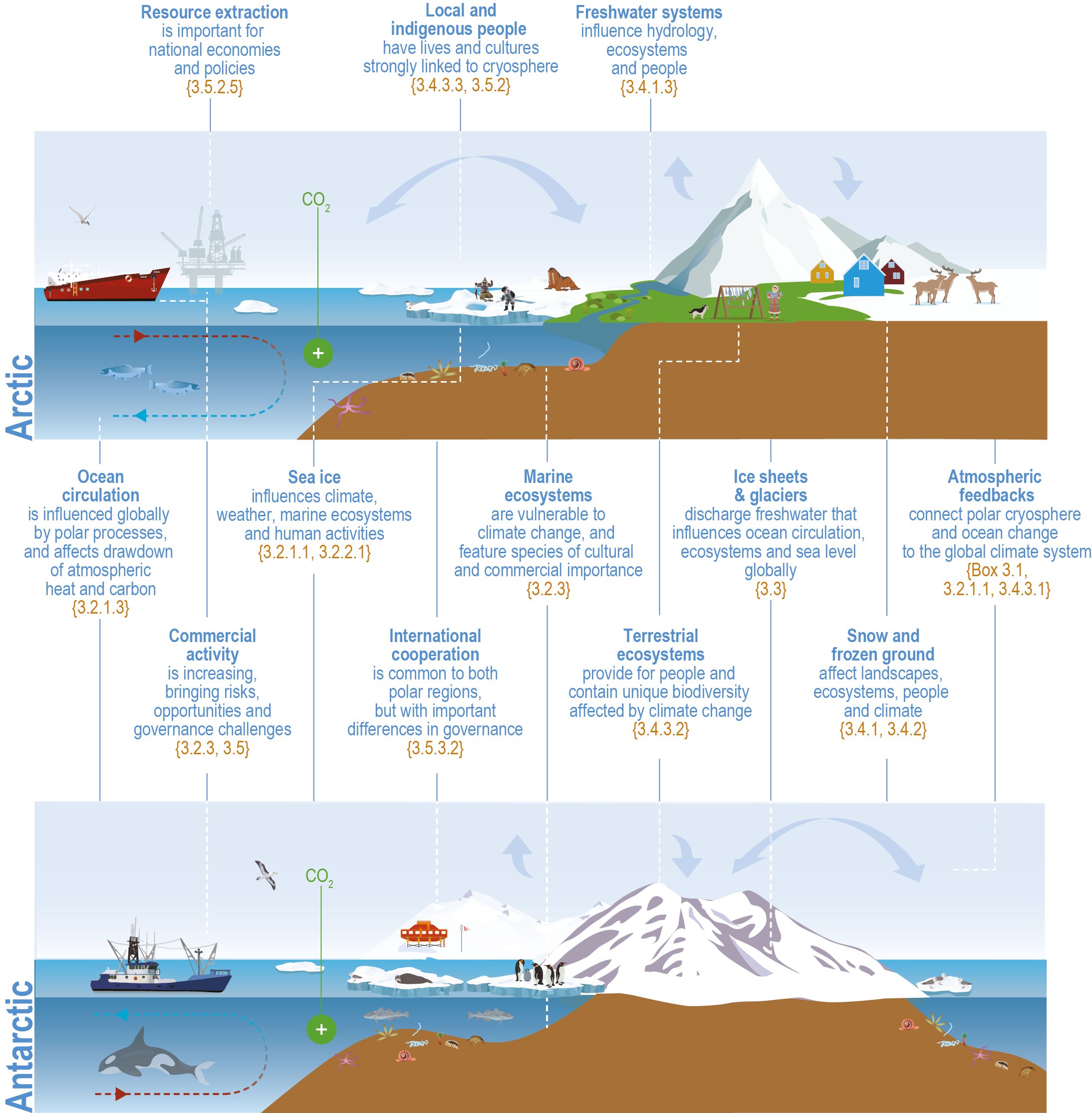How melting polar ice accelerates global climate feedbacks

The rapid melting of polar ice is triggering a cascade of global climate feedbacks, amplifying the effects of global warming. As Arctic and Antarctic ice sheets and glaciers melt at an unprecedented rate, the consequences are far-reaching, influencing weather patterns, sea levels, and ecosystems worldwide. The loss of ice cover not only contributes to rising sea levels but also disrupts the Earth's energy balance, leading to further warming and accelerating climate change. Understanding the complex interactions between melting ice and global climate feedbacks is crucial for predicting the future of our planet and mitigating the worst impacts of climate change.
- Accelerating Climate Change: The Impact of Melting Polar Ice
-
Understanding the Impact of Rapid Polar Ice Melting on Global Climate Feedback Loops
- What role does polar ice melting play in amplifying global climate change?
- Impact on Sea Levels and Ocean Currents
- Effects on Global Weather Patterns and Temperature
- Consequences for Ecosystems and Biodiversity
- What role does melting ice play in amplifying global warming through feedback mechanisms?
- Reduced Albedo Effect
- Changes in Ocean Circulation and Heat Transport
- Impacts on Global Energy Balance
- What role does thawing permafrost play in intensifying climate feedback mechanisms?
- Release of Greenhouse Gases
- Impact on Carbon Cycle
- Feedback Loops and Amplification
- What role does polar ice play in regulating Earth's climate system?
- Polar Ice and Global Temperature Regulation
- Influence on Ocean Currents and Circulation
- Impact on Sea Levels and Coastal Communities
- Frequently Asked Questions
Accelerating Climate Change: The Impact of Melting Polar Ice
The melting of polar ice is a critical component in the acceleration of global climate feedbacks. As the ice melts, it not only contributes to sea-level rise but also triggers a cascade of events that further exacerbate climate change. The reduction in ice cover reduces the Earth's albedo, or reflectivity, allowing more solar radiation to be absorbed, which in turn accelerates warming.
The Role of Arctic Ice in Global Climate Regulation
The Arctic ice plays a crucial role in regulating global climate patterns. The loss of sea ice in the Arctic not only affects local ecosystems but also has a profound impact on global weather patterns. The melting of Arctic ice disrupts the thermohaline circulation, a critical ocean current that helps distribute heat around the globe, potentially leading to more extreme weather events.
Impact on Global Weather Patterns and Ocean Currents
The melting of polar ice has a significant impact on global weather patterns and ocean currents. As the ice melts, it alters the temperature gradients between the equator and the poles, leading to changes in atmospheric circulation patterns. This, in turn, can result in more frequent and intense heatwaves, droughts, and storms. The changes in ocean currents and temperature also affect the distribution of marine life, potentially leading to the loss of biodiversity.
Consequences for Sea-Level Rise and Coastal Communities
The melting of polar ice contributes significantly to sea-level rise, posing a major threat to coastal communities and ecosystems. As the ice sheets and glaciers melt, they contribute to an increase in global sea levels, leading to more frequent and severe coastal flooding and erosion. This has significant implications for the displacement of communities, loss of infrastructure, and damage to ecosystems.
| Climate Feedbacks | Impact |
|---|---|
| Reduced Albedo | Increased absorption of solar radiation, accelerating warming |
| Disrupted Thermohaline Circulation | Changes in global weather patterns and ocean currents |
| Sea-Level Rise | Increased coastal flooding and erosion, displacement of communities |
Understanding the Impact of Rapid Polar Ice Melting on Global Climate Feedback Loops
What role does polar ice melting play in amplifying global climate change?

Polar ice melting plays a significant role in amplifying global climate change. The polar ice caps, which include the Arctic and Antarctic regions, contain a substantial amount of the world's freshwater ice. When this ice melts, it contributes to sea-level rise, alters global weather patterns, and affects various ecosystems.
Impact on Sea Levels and Ocean Currents
The melting of polar ice contributes to sea-level rise, which has far-reaching consequences, including coastal erosion, flooding, and saltwater intrusion into freshwater sources. As the ice melts, the resulting freshwater input can also impact ocean currents and circulation patterns. Some of the key effects include:
- Dilution of seawater, potentially weakening ocean circulation patterns
- Changes in ocean density, affecting global thermohaline circulation
- Increased sea levels, leading to more frequent and severe coastal flooding
Effects on Global Weather Patterns and Temperature
Polar ice melting can also influence global weather patterns and temperature. The ice-albedo feedback loop is a critical process where the melting of ice exposes darker surfaces that absorb more solar radiation, amplifying warming. This, in turn, can lead to changes in atmospheric circulation, potentially resulting in more extreme weather events. Some key aspects of this process include:
- Changes in atmospheric circulation patterns, potentially leading to more extreme weather
- Increased absorption of solar radiation due to reduced albedo
- Feedback loops that amplify warming and accelerate ice melting
Consequences for Ecosystems and Biodiversity
The melting of polar ice has significant implications for ecosystems and biodiversity. Many species, such as polar bears and penguins, rely on the ice for habitat, hunting, and breeding. As the ice melts, these species face increased competition for resources, reduced habitats, and potentially even extinction. Some of the key consequences include:
- Loss of habitat for ice-dependent species
- Changes in species distribution and abundance
- Increased vulnerability to climate-related stressors and extinction
What role does melting ice play in amplifying global warming through feedback mechanisms?

Melting ice plays a significant role in amplifying global warming through various feedback mechanisms. When ice melts, it exposes darker surfaces such as water or land, which have a lower albedo (reflectivity) compared to ice. As a result, these surfaces absorb more solar radiation, leading to increased heating and further melting of ice. This process creates a self-reinforcing cycle that accelerates global warming.
Reduced Albedo Effect
The reduced albedo effect is a primary feedback mechanism triggered by melting ice. As ice cover diminishes, the Earth's surface reflectivity decreases, allowing more solar radiation to be absorbed. This, in turn, enhances warming and promotes further ice melting. The consequences of reduced albedo are far-reaching, affecting not only the polar regions but also global climate patterns.
- The Arctic ice cap has lost about 75% of its thickness since the 1980s.
- The reduction in albedo due to melting ice contributes to increased absorption of solar radiation.
- This process is self-sustaining, as the increased temperature melts more ice, further reducing albedo.
Changes in Ocean Circulation and Heat Transport
Melting ice also influences global warming by altering ocean circulation and heat transport. Freshwater input from melting glaciers and ice sheets can disrupt ocean currents, potentially leading to changes in regional climate conditions. Moreover, the influx of cold freshwater can temporarily mask warming trends in certain areas, but ultimately, it contributes to the overall energy balance of the planet.
- Melting glaciers and ice sheets release freshwater into the ocean, affecting circulation patterns.
- Changes in ocean circulation can have significant impacts on regional climate conditions.
- The input of freshwater can influence the formation of sea ice and the thermohaline circulation.
Impacts on Global Energy Balance
The melting of ice affects the global energy balance by modifying the amount of solar radiation absorbed by the Earth's surface. As ice cover decreases, more radiation is absorbed, leading to an increase in the planet's energy budget. This, in turn, contributes to global warming, as the excess energy is distributed around the globe through atmospheric and oceanic circulation.
- The decrease in ice cover leads to increased absorption of solar radiation.
- This excess energy is distributed globally, contributing to warming trends.
- The resulting changes in climate patterns can have far-reaching consequences for ecosystems and human societies.
What role does thawing permafrost play in intensifying climate feedback mechanisms?

Thawing permafrost plays a significant role in intensifying climate feedback mechanisms. Permafrost, which is a frozen layer of soil and rock that stores large amounts of carbon dioxide and methane, has been thawing at an alarming rate due to rising global temperatures. As permafrost thaws, it releases these greenhouse gases into the atmosphere, contributing to further warming and creating a self-reinforcing cycle.
Release of Greenhouse Gases
The thawing of permafrost leads to the release of greenhouse gases, primarily carbon dioxide and methane, which are trapped in the frozen soil. This release occurs as the permafrost thaws and the previously frozen organic matter becomes available for microbial decomposition. The decomposition process consumes oxygen and releases greenhouse gases, contributing to an increase in atmospheric concentrations.
- The release of methane is particularly significant, as it has a global warming potential 28 times higher than carbon dioxide over a 100-year time frame.
- Thawing permafrost also leads to the formation of thermokarst lakes, which emit methane as a result of microbial activity in the lake sediments.
- The magnitude of greenhouse gas emissions from thawing permafrost is expected to increase as global temperatures continue to rise.
Impact on Carbon Cycle
Thawing permafrost affects the carbon cycle by releasing stored carbon into the atmosphere and altering the balance between carbon sequestration and emissions. As permafrost thaws, the carbon stored in the frozen soil is released, contributing to an increase in atmospheric carbon dioxide concentrations. Furthermore, the thawing of permafrost can lead to changes in vegetation and soil properties, influencing the ability of ecosystems to sequester carbon.
- Permafrost thaw can lead to the formation of wetlands, which can act as carbon sinks, but also emit methane.
- The loss of permafrost can alter soil moisture and temperature regimes, affecting the growth and productivity of vegetation.
- Changes in vegetation and soil properties can, in turn, influence the local climate, creating a complex feedback loop.
Feedback Loops and Amplification
Thawing permafrost is involved in several feedback loops that amplify its impact on the climate system. The release of greenhouse gases from thawing permafrost contributes to further warming, which, in turn, accelerates permafrost thaw. This self-reinforcing cycle is a classic example of a positive feedback loop.
- The amplification of climate change through permafrost thaw is expected to be most pronounced in high-latitude regions.
- The thawing of permafrost can also lead to changes in surface albedo, as the exposed soil and vegetation have different reflective properties than the original permafrost.
- The combination of these feedback loops can lead to non-linear and potentially abrupt changes in the climate system.
What role does polar ice play in regulating Earth's climate system?

Polar ice plays a crucial role in regulating Earth's climate system. It helps to maintain the planet's temperature by reflecting sunlight back into space, a process known as albedo. The ice sheets and glaciers in the polar regions are highly reflective, and this reflectivity helps to cool the planet by reducing the amount of solar radiation that is absorbed.
Polar Ice and Global Temperature Regulation
Polar ice is essential for regulating global temperatures. The ice sheets and glaciers in the polar regions help to moderate the Earth's temperature by reflecting sunlight and influencing ocean currents. The melting of polar ice can disrupt this process, leading to changes in global temperatures.
- The extent and thickness of polar ice cover affects the amount of solar radiation that is reflected back into space.
- Changes in polar ice cover can impact global temperatures by altering the amount of heat that is absorbed by the oceans.
- The melting of polar ice can also lead to changes in ocean circulation patterns, which can in turn affect regional climate conditions.
Influence on Ocean Currents and Circulation
Polar ice also plays a significant role in shaping ocean currents and circulation patterns. The formation and melting of sea ice in the polar regions help to drive ocean circulation, which in turn affects regional climate conditions and marine ecosystems.
- The density of seawater is influenced by the formation of sea ice, which can lead to the sinking of dense water and the formation of deep-water currents.
- The melting of sea ice can also impact ocean circulation by freshening the surface waters and reducing the density of the water.
- Changes in ocean circulation patterns can have significant impacts on regional climate conditions, including temperature, precipitation, and weather patterns.
Impact on Sea Levels and Coastal Communities
The melting of polar ice has significant implications for sea levels and coastal communities. As the ice sheets and glaciers in the polar regions melt, they contribute to sea level rise, which can have devastating impacts on coastal communities and ecosystems.
- The melting of polar ice is a major contributor to sea level rise, with significant implications for coastal communities and ecosystems.
- The loss of polar ice can also lead to changes in ocean tides and coastal erosion patterns.
- Coastal communities and ecosystems are vulnerable to the impacts of sea level rise, including flooding, erosion, and saltwater intrusion.
Frequently Asked Questions
What is the impact of melting polar ice on global climate?
Melting polar ice accelerates global climate feedbacks by reducing Earth's albedo, or reflectivity, allowing more solar radiation to be absorbed, thus amplifying warming. This, in turn, triggers other feedback loops, such as thawing permafrost and releasing methane, further exacerbating climate change. The consequences include rising sea levels, altered ecosystems, and disrupted global weather patterns.
How does the loss of sea ice influence ocean currents?
The loss of sea ice in polar regions influences ocean currents by altering the salinity and temperature gradients that drive thermohaline circulation. Freshwater input from melting ice can weaken ocean circulation, potentially leading to regional cooling or changes in precipitation patterns. This, in turn, can have cascading effects on marine ecosystems and global climate regulation.
What role does melting permafrost play in climate feedbacks?
Melting permafrost plays a significant role in climate feedbacks by releasing stored greenhouse gases, particularly methane and carbon dioxide, into the atmosphere. As permafrost thaws, microbes decompose organic matter, producing these gases and amplifying global warming. This feedback loop is self-reinforcing, as increased temperatures accelerate permafrost thawing, releasing more greenhouse gases.
Can the melting of polar ice be reversed?
Reversing the melting of polar ice is challenging and would require significant reductions in global greenhouse gas emissions. Limiting warming to 1.5°C above pre-industrial levels is crucial to preserving polar ice. However, even if emissions are reduced, the polar ice caps may take centuries to recover, and some changes may be irreversible due to the complexity and non-linearity of climate feedbacks.

Leave a Reply